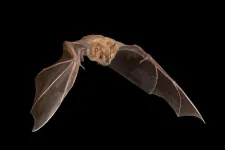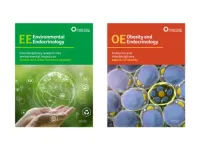(Press-News.org) Many human medications can directly inhibit the growth and alter the function of the bacteria that constitute our gut microbiome. EMBL Heidelberg researchers have now discovered that this effect is reduced when bacteria form communities.
In a first-of-its-kind study, researchers from EMBL Heidelberg's Typas, Bork, Zimmermann, and Savitski groups, and many EMBL alumni, including Kiran Patil (MRC Toxicology Unit Cambridge, UK), Sarela Garcia-Santamarina (ITQB, Portugal), André Mateus (Umeå University, Sweden), as well as Lisa Maier and Ana Rita Brochado (University Tübingen, Germany), compared a large number of drug-microbiome interactions between bacteria grown in isolation and those part of a complex microbial community. Their findings were recently published in the journal Cell.
For their study, the team investigated how 30 different drugs (including those targeting infectious or noninfectious diseases) affect 32 different bacterial species. These 32 species were chosen as representative of the human gut microbiome based on data available across five continents.
They found that when together, certain drug-resistant bacteria display communal behaviours that protect other bacteria that are sensitive to drugs. This 'cross-protection' behaviour allows such sensitive bacteria to grow normally when in a community in the presence of drugs that would have killed them if they were isolated.
“We were not expecting so much resilience,” said Sarela Garcia-Santamarina, a former postdoc in the Typas group and co-first author of the study, currently a group leader in the Instituto de Tecnologia Química e Biológica (ITQB), Universidade Nova de Lisboa, Portugal. “It was very surprising to see that in up to half of the cases where a bacterial species was affected by the drug when grown alone, it remained unaffected in the community.”
The researchers then dug deeper into the molecular mechanisms that underlie this cross-protection. “The bacteria help each other by taking up or breaking down the drugs,” explained Michael Kuhn, Research Staff Scientist in the Bork Group and a co-first author of the study. "These strategies are called bioaccumulation and biotransformation respectively".
“These findings show that gut bacteria have a larger potential to transform and accumulate medicinal drugs than previously thought,” said Michael Zimmermann, Group Leader at EMBL Heidelberg and one of the study collaborators.
However, there is also a limit to this community strength. The researchers saw that high drug concentrations cause microbiome communities to collapse and the cross-protection strategies to be replaced by 'cross-sensitisation'. In cross-sensitisation, bacteria which would normally be resistant to certain drugs become sensitive to them when in a community – the opposite of what the authors saw happening at lower drug concentrations.
“This means that the community composition stays robust at low drug concentrations, as individual community members can protect sensitive species," said Nassos Typas, an EMBL group leader and senior author of the study. "But, when the drug concentration increases, the situation reverses. Not only do more species become sensitive to the drug and the capacity for cross-protection drops, but also negative interactions emerge, which sensitise further community members. We are interested in understanding the nature of these cross-sensitisation mechanisms in the future.”
Just like the bacteria they studied, the researchers also took a community strategy for this study, combining their scientific strengths. The Typas Group are experts in high-throughput experimental microbiome and microbiology approaches, while the Bork Group contributed with their expertise in bioinformatics, the Zimmermann Group did metabolomics studies, and the Savitski Group did the proteomics experiments. Among external collaborators, EMBL alumnus Kiran Patil's group at Medical Research Council Toxicology Unit, University of Cambridge, United Kingdom, provided expertise in gut bacterial interactions and microbial ecology.
As a forward-looking experiment, authors also used this new knowledge of cross-protection interactions to assemble synthetic communities that could keep their composition intact upon drug treatment.
“This study is a stepping stone towards understanding how medications affect our gut microbiome. In the future, we might be able to use this knowledge to tailor prescriptions to reduce drug side effects," said Peer Bork, Group Leader and Director at EMBL Heidelberg. “Towards this goal, we are also studying how interspecies interactions are shaped by nutrients so that we can create even better models for understanding the interactions between bacteria, drugs, and the human host,” added Patil.
END
Better together: Gut microbiome communities’ resilience to drugs
Bacteria that are sensitive to drugs can become resilient when part of communities, with the help of cross-protection strategies
2024-09-24
ELSE PRESS RELEASES FROM THIS DATE:
More to munch on: The popcorn planet WASP-107b unveils new atmospheric details
2024-09-24
The "popcorn planet" is back in the spotlight! Using NASA's James Webb Space Telescope (JWST), a team of international astronomers has discovered new atmospheric details on WASP-107b, an exoplanet with a puffed-up atmosphere due to tidal heating. Previously described as an extremely low-density "popcorn planet" by researchers, WASP-107b has once again proven to be an intriguing subject, revealing even more surprising characteristics about its inflated and dynamic atmosphere.
WASP-107b, a gas giant about the size of Jupiter but with just one-tenth of its mass, has ...
Innovative electrolytes could transform steelmaking and beyond
2024-09-24
The lifeblood of any battery is the electrolyte. It is the medium through which positively charged elements (cations) migrate en masse between the positive and negative electrodes. By this means, batteries discharge to provide energy and charge to store energy. Scientists call this an electrochemical process.
Electrolytes are central to the development of different electrochemical processes, as well. For example, they could be used in converting iron ore into purified iron metal or iron alloys. A challenge is that the electrolyte must remain stable under extreme operating conditions and avoid side reactions that reduce energy efficiency. The payoff ...
Planting seeds for safer farming
2024-09-24
Per- and polyfluoroalkyl substances (PFAS) are human-made chemicals that were introduced in the 1940s. PFAS are used to create a variety of products including water-resistant clothing, non-stick cookware, and firefighting foams.
Unfortunately, PFAS can have negative effects on health, including increases in cholesterol levels and changes to liver function. Using PFAS-containing products can lead to their presence in the treated wastewater and treated sludge (referred to as biosolids). When grown on biosolid-amended farmland soils or irrigated with treated wastewater, crops can bioaccumulate PFAS. The PFAS-accumulated crops can be consumed directly by the public or indirectly ...
Fruit-only diet improves bats’ immune response to viruses
2024-09-24
Fruit bats generate more diverse antibodies than mice, but overall have a weaker antibody response, according to a new study published September 24th in the open-access journal PLOS Biology by Dan Crowley from Cornell University, USA, and colleagues.
Bats are well-known reservoirs for viruses with pandemic potential. While these viruses typically do not cause disease in bats, they can prove deadly in humans. Spillover events—transmission of a virus from a reservoir population (eg, bats) to a new host population ...
Placebo pain relief and positive treatment expectations are not caused by dopamine
2024-09-24
New findings argue against a direct causal role for dopamine during the experience of a treatment effect in the establishment of positive treatment expectations and placebo analgesia in healthy volunteers, according to a study published September 24th in the open-access journal PLOS Biology by Ulrike Bingel from University Hospital Essen, Germany, and colleagues.
Dopamine-based reward and learning mechanisms have been suggested to contribute to placebo effects. However, the exact role of the brain messenger molecule dopamine in their generation and maintenance is still unclear. ...
New guideline details how to manage CVD risk before, during & after noncardiac surgery
2024-09-24
Guideline highlights:
The American Heart Association and the American College of Cardiology joint guideline addressing cardiovascular evaluation and management of patients before, during and after noncardiac surgery reviews a decade of new evidence and provides updates since the last guideline in 2014.
The updates in the guideline are intended for patients scheduled for noncardiac surgery from preoperative evaluation through postoperative care and include appropriate use of cardiovascular testing and screening, management of cardiovascular conditions and risks, and recommendations for those taking sodium-glucose ...
Silvia Cavagnero to receive 2025 Emily M. Gray Award
2024-09-24
ROCKVILLE, MD – The Biophysical Society is pleased to announce that Silvia Cavagnero, PhD, of the University of Wisconsin-Madison, has been named the recipient of the 2025 Emily M. Gray Award. Cavagnero will be honored at the Society’s 69th Annual Meeting, being held in Los Angeles, California from February 15-19, 2025.
Cavagnero is being honored for developing courses, innovating instructional methods, mentoring students at all levels, and promoting diversity in biophysics.
“Silvia is an accomplished biophysicist and a born educator,” ...
European Society of Endocrinology expands journal portfolio with the launch of Environmental Endocrinology and Obesity and Endocrinology
2024-09-24
The European Society of Endocrinology (ESE) is delighted to announce the launch of two new multidisciplinary, open-access journals, Environmental Endocrinology and Obesity and Endocrinology. The Journals will be published by Oxford University Press, with the launch issues scheduled for Q2 2025. Submissions are now being welcomed via the Journals' websites.
Environmental Endocrinology will publish high-quality clinical, translational, and basic research on all aspects of environmental impacts on hormone systems in humans and living systems, incorporating the One Health perspective. The Journal will welcome submissions from a broad range ...
Atmospheric blocking slows ocean-driven melting of Greenland’s largest glacier tongue
2024-09-24
Northeast Greenland is home to the 79° N Glacier – the country’s largest floating glacier tongue, but also one seriously threatened by global warming: warm water from the Atlantic is melting it from below. Experts from the Alfred Wegener Institute have however now determined that the temperature of the water flowing into the glacier cavern declined from 2018 to 2021, even though the ocean has steadily warmed in the region over the past several decades. This could be due to temporarily changed atmospheric circulation patterns. ...
Improved cement to protect the living treasures of our coastlines
2024-09-24
WASHINGTON, Sept. 24, 2024 – Coastlines are vital to our world’s ecology and economy. Coastal ecosystems help maintain biodiversity, provide natural barriers against erosion, storms, and flooding, and act as large carbon sinks to reduce greenhouse gases. Sustainable fisheries and seaside tourist venues support local economies.
Natural coastlines, including coral reefs, marshes, and mangroves, are complete and stable, capable of self-regulation and restoration. That is, unless human interventions, such as urbanization, overdevelopment, pollution, and human-made erosion, make these areas vulnerable to devastation.
Artificial coastlines, ...
LAST 30 PRESS RELEASES:
A new way to map how cells choose their fate
Numbers in our sights affect how we perceive space
SIMJ announces global collaborative book project in commemoration of its 75th anniversary
Air pollution exposure and birth weight
Obstructive sleep apnea risk and mental health conditions among older adults
How talking slows eye movements behind the wheel
The Ceramic Society of Japan’s Oxoate Ceramics Research Association launches new international book project
Heart-brain connection: international study reveals the role of the vagus nerve in keeping the heart young
Researchers identify Rb1 as a predictive biomarker for a new therapeutic strategy in some breast cancers
Survey reveals ethical gaps slowing AI adoption in pediatric surgery
Stimulant ADHD medications work differently than thought
AI overestimates how smart people are, according to HSE economists
HSE researchers create genome-wide map of quadruplexes
Scientists boost cell "powerhouses" to burn more calories
Automatic label checking: The missing step in making reliable medical AI
Low daily alcohol intake linked to 50% heightened mouth cancer risk in India
American Meteorological Society announces Rick Spinrad as 2026 President-Elect
Biomass-based carbon capture spotlighted in newly released global climate webinar recording
Illuminating invisible nano pollutants: advanced bioimaging tracks the full journey of emerging nanoscale contaminants in living systems
How does age affect recovery from spinal cord injury?
Novel AI tool offers prognosis for patients with head and neck cancer
Fathers’ microplastic exposure tied to their children’s metabolic problems
Research validates laboratory model for studying high-grade serous ovarian cancer
SIR 2026 delivers transformative breakthroughs in minimally invasive medicine to improve patient care
Stem Cell Reports most downloaded papers of 2025 highlight the breadth and impact of stem cell research
Oxford-led study estimates NHS spends around 3% of its primary and secondary care budget on the health impacts of heat and cold in England
A researcher’s long quest leads to a smart composite breakthrough
Urban wild bees act as “microbial sensors” of city health.
New study finds where you live affects recovery after a hip fracture
Forecasting the impact of fully automated vehicle adoption on US road traffic injuries
[Press-News.org] Better together: Gut microbiome communities’ resilience to drugsBacteria that are sensitive to drugs can become resilient when part of communities, with the help of cross-protection strategies







